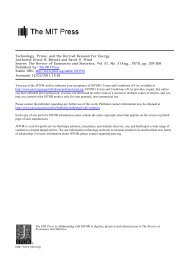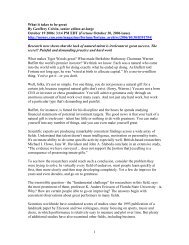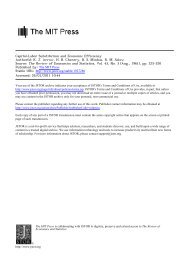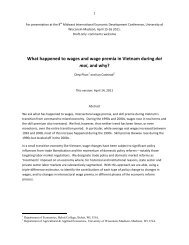Status of Wisconsin Agriculture 2010 - Agricultural & Applied ...
Status of Wisconsin Agriculture 2010 - Agricultural & Applied ...
Status of Wisconsin Agriculture 2010 - Agricultural & Applied ...
You also want an ePaper? Increase the reach of your titles
YUMPU automatically turns print PDFs into web optimized ePapers that Google loves.
farmers and other industry participants to work together<br />
in networks, cooperatives, farm groups and other types<br />
<strong>of</strong> organizations. In these collaborative efforts, farmers<br />
discover ways to improve their efficacy on the farm, in<br />
the marketplace and in social and political forums that<br />
shape their well-being. The rest <strong>of</strong> this article explores<br />
one <strong>of</strong> those collaborative efforts, Organic Valley Cooperative,<br />
and how it was able to undertake an effective<br />
supply management strategy in 2009.<br />
The 1990s Call for Price Stability through<br />
Supply Management<br />
Organic Valley’s formation brought together several<br />
currents in <strong>Wisconsin</strong> agriculture. One <strong>of</strong> these, related<br />
to supply management, dates back to the mid 1990s,<br />
when dairy farmers, especially in Western <strong>Wisconsin</strong>,<br />
were discussing the potential <strong>of</strong> farmer-led supply<br />
management initiatives to improve prices. In 1996, Congress<br />
had voted to remove explicit government support<br />
for grain prices, and milk prices were beginning the<br />
rollercoaster ride we have seen over the past 15 years.<br />
As a participant in some <strong>of</strong> those meetings, I witnessed<br />
much heated debate about whether farmer-led supply<br />
management efforts could work, and what support from<br />
the university, state agencies and other leaders might or<br />
might not do.<br />
As a newcomer to <strong>Wisconsin</strong> dairy issues, I was quiet<br />
most <strong>of</strong> the time. When I <strong>of</strong>fered my two-cents, I usually<br />
came across as a wet blanket. It just did not seem feasible<br />
to me that <strong>Wisconsin</strong> dairy farmers could achieve<br />
supply management in the U.S. market without explicit<br />
coordination with the federal government or several<br />
major national processors, and the prospects for support<br />
from those quarters seemed unlikely in an era when<br />
financial markets were booming and market deregulation<br />
was the mantra. Simply put, supply management<br />
policies were out <strong>of</strong> favor politically.<br />
Moreover, as a student <strong>of</strong> cartel<br />
efforts <strong>of</strong> mineral- and even bananaexporting<br />
countries around the<br />
world, the only time I had under-<br />
26<br />
stood those efforts to be effective<br />
24<br />
was when central coordination was<br />
provided by major, low-cost leaders<br />
22<br />
for very critical resources (like oil).<br />
On those occasions, when I was<br />
asked by farmers what I could do to<br />
help, I had little to <strong>of</strong>fer except economic<br />
rationales for government<br />
support that might point to how<br />
improvements in efficiency and productivity<br />
could be associated with<br />
reducing price instability. Needless<br />
to say, the weight <strong>of</strong> history buried<br />
20<br />
18<br />
16<br />
14<br />
12<br />
10<br />
supply management initiatives in conventional dairy<br />
markets, other than occasional voluntary programs. And<br />
while they have been mentioned by some industry participants<br />
during the past 18 months <strong>of</strong> low dairy prices,<br />
they are not really in play in many farm organization<br />
discussions or in federal policy circles.<br />
Organic Milk Supply Management in 2008-09<br />
Take a look now at the figure that compares pay prices<br />
for Organic Valley milk to conventional milk over the<br />
past two decades. It shows the roller-coaster ride <strong>of</strong> conventional<br />
milk prices alongside a mostly steady rise in<br />
the pay price for dairy farmers associated with Organic.<br />
While it is easy to focus on the price premium associated<br />
with organics, which can be quite high at times<br />
(more than $9/hundredweight in 2006), the other major<br />
difference in comparison with conventional milk prices<br />
has been the relative stability <strong>of</strong> organic milk prices.<br />
Until recently, that stability could readily be attributed to<br />
the exponential rise in demand for organic products during<br />
what Organic Valley CEO George Siemon has called<br />
the “organic gold rush” (Siemon). In several years prior<br />
to 2008, Organic Valley experienced more than a 20 percent<br />
annual growth in sales, which explains how the<br />
Cooperative went from under 100 dairy farm members<br />
in the 1990s to more than 1,000 in 2008. A regional<br />
snapshot <strong>of</strong> that growth is illustrated by a time series <strong>of</strong><br />
maps that shows the growth in organic dairy farms in<br />
the six counties closest to Organic Valley’s headquarters<br />
in LaFarge.<br />
There was more to that price stability than just demand<br />
growth, however. From the beginning, Organic Valley<br />
organizers, many <strong>of</strong> whom were active in the 1990s supply<br />
management efforts, have attempted to coordinate<br />
supply (what they call “pools”) with demand at a<br />
regional level. These pools are organized to add produc-<br />
Pay Prices for Organic Valley and Conventional Milk in <strong>Wisconsin</strong><br />
$ per Hundredweight<br />
Organic Valley Pay Price<br />
<strong>Wisconsin</strong> All-Milk Price<br />
1990 1992 1994 1996 1998 2000 2002 2004 2006 2008<br />
STATUS OF WISCONSIN AGRICULTURE <strong>2010</strong>—FRAMING THE FINANCIAL CRISIS 45







